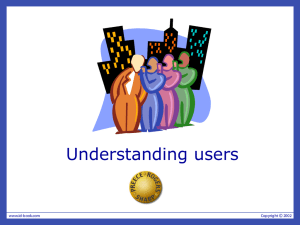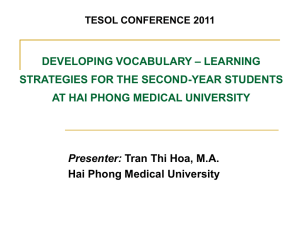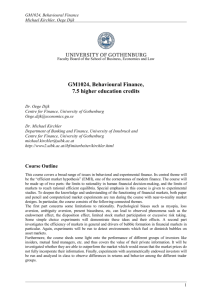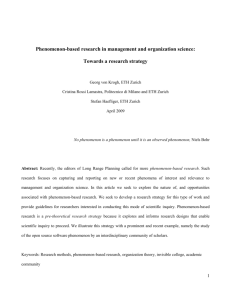What is Consumer Credit?
advertisement
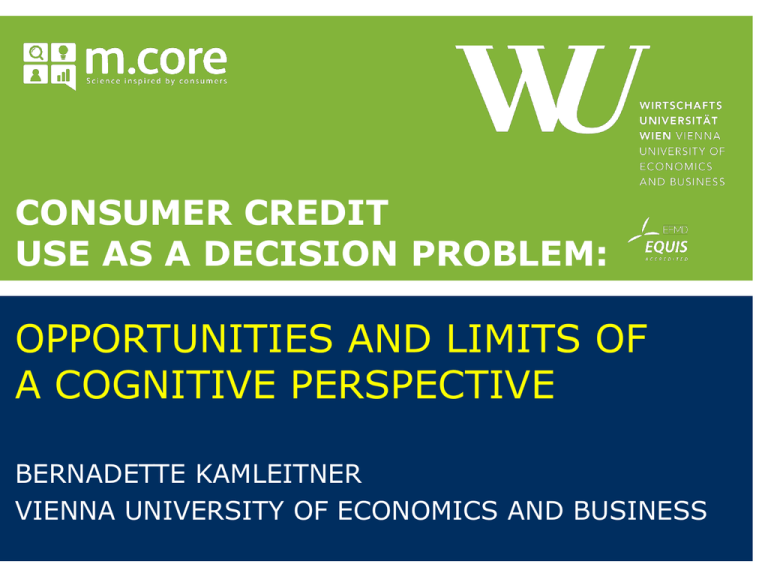
CONSUMER CREDIT USE AS A DECISION PROBLEM: OPPORTUNITIES AND LIMITS OF A COGNITIVE PERSPECTIVE BERNADETTE KAMLEITNER VIENNA UNIVERSITY OF ECONOMICS AND BUSINESS Setting the scene CREDIT USE Financial crisis has curbed borrowing in some countries e.g. UK: personal loan market decreased by 6% consumer borrowing still 43% of GDP (Mintel.com, 2010) Credit use keeps rising in many emerging markets e.g., China: personal loans expected growth more than 20% p.a. over the next 5 yrs (Mintel.com, 2010) Consumer credit is a global economic force WHAT IS CONSUMER CREDIT? = credit obtained [by private households] to finance any purchase other than property (Guardia, 2002, p. 2) = all kinds of installment credit (e.g. credit cards) as well as non- installment credit except mortage debt (i.e. real estate secured by real estate) (Kamleitner & Kirchler, 2007, p. 268) a special form of consumption (e.g., Jesus & Oliveira, 2013) a socially accepted financial practice (Merskin, 1998) WHAT IS CONSUMER CREDIT? The theoretical definition of consumer credit is quite clear. BUT: the concepts in peoples’ minds are not (e.g. Viaud & Roland- Lévy, 2000; Lea, 1999) INCOME DEBT BORROW Purpose Time span Type of creditor Formalisation of arrangement CREDIT PURCHASE What is the focus of the decision? WHAT I AIM TO DO • broad look at the phenomenon from a psychological perspective • not problem-based • big picture rather than details • search for directions rather than knowing the way THE PHENOMENON DIFFERENT LENSES ON THE PHENOMENON Credit use as …. ………..a psychological phenomenon ………..a process Kamleitner, Hölzl & Kirchler 2012 PSYCHOLOGICAL PHENOMENON: REFLECTION OF THE SITUATION € PSYCHOLOGICAL PHENOMENON: REFLECTION OF THE PERSON PSYCHOLOGICAL PHENOMENON: A SOCIAL PRACTICE PSYCHOLOGICAL PHENOMENON: A DECISION AND COGNITIVE PROCESS Credit use before at Kamleitner & Kirchler 2007 after CREDIT USE AS A PROCESS Credit use at Buy after What Whether How to before BEFORE CREDIT USE after at Which credit? Credit use before AT CREDIT TAKE UP after at What now? Credit use before AFTER CREDIT TAKE UP BRINGING THE PERSPECTIVES TOGETHER 2 at a time after at before RESEARCH THEMES PERSPECTIVE: REFLECTION OF THE SITUATION demographics Credit availability economic background Life events Access as DV Search as DV Repayment as a function of situation Credit use as IV Desire for now Desire for good Desire for credit after at before RESEARCH THEMES PERSPECTIVE: REFLECTION OF THE PERSON Repayment as a function of person Credit use as IV: well being, attitude after at before RESEARCH THEMES PERSPECTIVE: A SOCIAL PRACTICE society Reference group stimulating desire Access as DV Credit use as learned Borrowerlender Repayment as a function social influences Credit use as IV: social life CREDIT USE AS A DECISION AND COGNITIVE PROCESS at before RESEARCH THEMES PERSPECTIVE: A COGNITIVE PROCESS Intertemporal trade offs Rational reasons Info search Mental accounting installments after knowledge Credit perception duration Cost& interests Credit use as DV: knowledge Credit use as IV: thinking patterns risk at before RESEARCH THEMES PERSPECTIVE: A COGNITIVE PROCESS Intertemporal trade offs Rational reasons Info search Mental accounting installments after knowledge Credit perception duration Cost& interests Credit use as DV: knowledge Credit use as IV: thinking patterns risk RATIONAL(ISED) REASONS weighting pros and cons • Self-control through commitment/ protect savings (Erasmus & Mathunjwa, 2011) • Take advantage of a temporary offer (Erasmus & Mathunjwa, 2011) • Translate expectations into effective demand (Christie & Munro, 2003) Intertemporal trade- offs • Present rewards loom larger & Future costs loom smaller • (e.g., Loewenstein & Thaler, 1989; Webley & Nyhus, 2008) • Particularly pronounced for small loans MENTAL ACCOUNTING mentally separating/ tracking income and expenditures (Thaler, 1980) match source and purpose (Karlsson, Gärling & Selart, 1997) Integrate anticipated (discounted) pleasure and pain over time – debt aversion except for long-lasting goods (Prelec & Loewenstein, 1998) Double-Mental Entry accounting Coupling the degree to which thoughts of payment arouse thoughts of consumption and vice versa (Prelec & Loewenstein, 1998) α payment consumption β α (attenuation) degree to which thoughts related to consumption evoke thoughts of payment β (buffering) degree to which thoughts related to payment evoke thoughts of consumption Benefit-to-cost association Cost-to-benefit association at before RESEARCH THEMES PERSPECTIVE: A COGNITIVE PROCESS Intertemporal trade offs Rational reasons Info search Mental accounting installments after knowledge Credit perception duration Cost& interests Credit use as DV: knowledge Credit use as IV: thinking patterns risk Search for information = relevant for reaching an economically sound decision - Low levels of information search (e.g., Peterson & Black, 1984) - Failure to search may be due to the perception of high search and switch costs (Canner & Lucket, 1992) Searching does not necessarily translate into better decisions PERCEPTION OF CREDIT COMPONENTS Consumers care most about immediate implications 1. Monthly repayment amount (e.g., Herrmann & Wricke, 1998; Ranyard & Craig, 1995; Ranyard, Hinkley, Williamson, & McHugh, 2006) 2. Loan duration 3. Total costs 4. Interest rates Consumers care less about auxiliary features; e.g. rebates (e.g., Wonder, Wilhelm, & Fewings, 2008) Credit components: select Peculiarities First digit and “psychological odd” numbers - rates look smaller (Estelami, 2001; Wonder et al., 2008) “Get it over with” (e.g., Amar et al 2011, Wonder et al., 2008) Unwillingness to commit very long Reduce comittment (e.g., Hoelzl, Kamleitner, & Kirchler, 2011) little interest understanding but APR as price (e.g., Herrmann & Wricke, 1998, McHugh et al., 2011) Duration underestimated (e.g.,Overton & MacFaden, 1998) Risk denial for short, small loans Hinckley & Williamson, 2001) (Ranyard, Financial knowledge Knowledge can help but not necessarily a lot (e.g., Campbell, 2006 Levinger et al 2011) more knowledgeable consumers receive better credit scores (Perry, 2008). at before RESEARCH THEMES PERSPECTIVE: A COGNITIVE PROCESS Intertemporal trade offs Rational reasons Info search Mental accounting installments after knowledge Credit perception duration Cost& interests Credit use as DV: knowledge Credit use as IV: thinking patterns risk Credit perception Perception sometimes turns favorable: an alternative form of income a delayed agreed payment (Norton, 1993) (Katona, 1975) Reference point shifted to being in debt (Beggan, 1994) Loan burden: Habituation or recollection and forecasting bias? (Hölzl, Pollai & Kamleitner, 2009) Is loan perceived as connected to the good – coupling? (Kamleitner, Kirchler 2006; Kamleitner, Hölzl, Kirchler, 2010; Kamleitner et al. 2011) Depends on product Extent of indebtedness If yes, increased payment pain (Financial) knowledge people often badly informed about their credit plans (Emmons, 2004) Most people know: how much their monthly installment is how large a part of their income that is (Katona, 1975) Financial knowledge in general: those who owe more, know more Knowledge in terms of financial literacy can help (Bolton et al., 2011) CREDIT USE A RICH FIELD FOR FURTHER INQUIRY Challenges and limitations SEITE 36 Current specific challenges across perspectives geographic gap Cultural differences? pre – past crisis gap Can research done before the financial crisis be compared with “past crisis” research? measurement What is consumer credit? Different types of credit – same theories? The merrits of a cognitive perspective The smallest common denominator Equally important across the phases Can deal with different decisions and decision components SEITE 39 The main current limitation: assumption that people pay attention to the credit part of a decision …..some specific challenges/ opportunities GAP & OPPORTUNITY Social aspects as decision moderators? Decison for n >1, advisor and advisee, the role of culture… GAP & OPPORTUNITY offering versus process GAP & OPPORTUNITY Getting money versus good GAP & OPPORTUNITY Economical versus emotional optimization Bias and Outcome GAP & OPPORTUNITY Is credit special? Credit as a feature of the offering payment type alters product perception (Chatterjee, Rose 2012, Hahn et al. forthcoming; Kamleitner, Erki, 2013) General challenges Are we blinded by knowledge/ perspectives? Are we investigating the right people at the right time? Are we thinking about the phenomenon in the right way? Cause or consequence? A phenomenon in its own right? How many phenomena are we actually talking about? Are we keeping up with the trends Do we have the right methods? New forms of payment Crowd financing 0% loans Digital goods and new media WHAT‘S THE MESSAGE? Keep an eye on the evolution of the phenomenon credit use A cognitive perspective may help doing that without getting lost in the process Thank you for your attention! Univ. Prof. DDr. Bernadette Kamleitner Department Marketing Welthandelsplatz 1, 1020 Wien E-Mail: bernadette.kamleitner@wu.ac.at Tel.: +43 131336 4614




